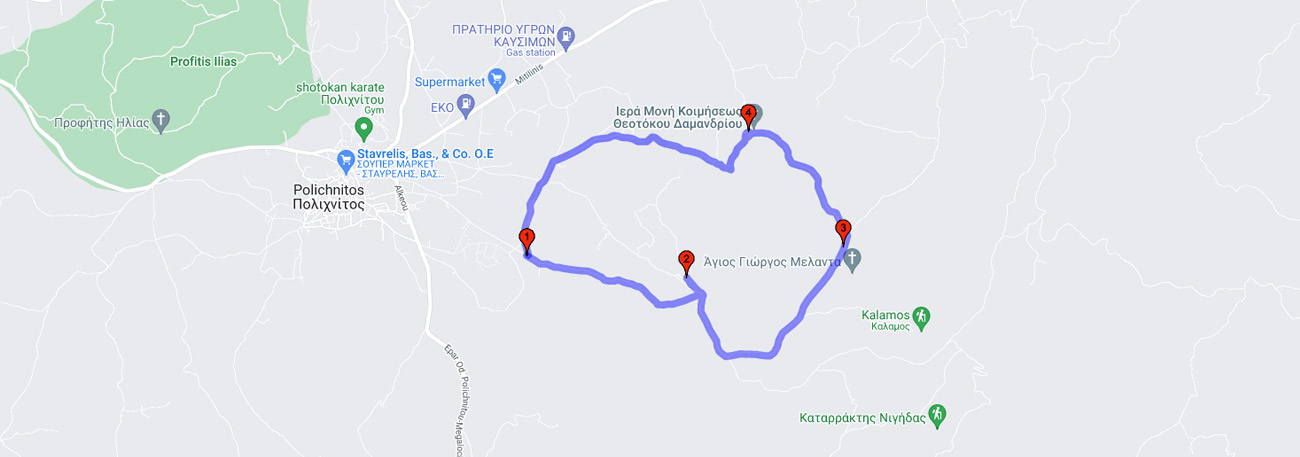Polichnitos hot springs - Melanta - Moni Damandriou - Palaiomonastira - Polichnitos hot springs

| General description: |
Hiking trail with great cultural interest among olive groves, pine forests, scattered oak trees, piles of rocks, wildflowers. |
| Detail description: |
From the installation area starts the Circular Route, which initially heads southeast and then climbs northeast towards the plateau. The first stop is at Agios Georgios Melanta, a small monastery that belongs to the Monastery of Damantrio. On the feast day of the popular saint, crowds of faithful from the villages of the area gather here. In the Damantrio area, there used to be a village of the same name, which its residents abandoned and the place became deserted. The Monastery became the guardian of the area, with the village church as its parish. After many adventures, the buildings are now being restored. It is a place of history, religiosity, and, for the hiker, a resting place before the rest of the journey towards Thermopylae, for a delightful bath. |
| Transportation means: |
Car and bus to Polichnítos |
| Accessibility: |
Asphalted access to Polichnítos, connection to rural road construction |
| Best season: |
Spring, Autumn |
| Places to visit: |
Monastery of Damandario, Monastery of Agios Georgios Melanta |
| Signage: |
Yes |
| Route starting point: |
Polichnítos |
| End of Route: |
Polichnítos |
| Type of tourism: |
Walk/hike, cultural |
Points of interest
Polichnitos hot springs
| Name: |
Polichnitos hot springs |
| Description: |
Natural hot springs |
| Category: |
Natural Landscape/Monument |
| Longitude: |
39.074661 |
| Latitude: |
26.199694 |
| Altitude: |
55 |
The thermal baths of Polichnitos have been in use since the Ottoman era and originate from many sources, through volcanic primary and secondary porous rocks. Their temperature ranges between 67°C and 92°C (in the baths, it ranges between 42°C and 44°C) and are considered among the hottest in Europe. They are rich in chlorides and are comparable to those in Wiesbaden, Germany. Water flows freely and steams, coloring the bottom red with thermophilic plants that grow there. Behind a forest of rushes stands a complex of buildings, with long narrow chambers and the ridged structures of the old reservoirs. Continuing the description, we must mention the small three-arched bridge over the Almyropotamos (one of the few that survives to this day) and further on the old fountain made of yellow and pink soft stone.
Melanta
| Name: |
Melanta |
| Description: |
Church/Monastery |
| Category: |
Cultural elements |
| Longitude: |
39.073604 |
| Latitude: |
26.231077 |
| Altitude: |
253 |
It is a single-nave church with old icons and a traditional carved temple, which was recently rebuilt from scratch in Agiasos as a donation from a faithful believer. Its sanctuary is made of hewn stone blocks, embedded bricks, and three large arched windows. There are cells in the courtyard where visitors, who are numerous especially during the summer months and in August, stay to "fifteen" and perform an offering to the Saint.
Around the church, there are large rectangular stone blocks, bricks, and tiles that indicate the existence of buildings in the past. Carved jugs made of brown stone and the upright cover of a sarcophagus are also present in the soil.
Moni Damandriou
| Name: |
Moni Damandriou |
| Description: |
Church/Monastery |
| Category: |
Cultural elements |
| Longitude: |
39.084133 |
| Latitude: |
26.221618 |
| Altitude: |
173 |
Damantrion (or Damantri) was a village in the Polichnitos region during the 16th century, but many small villages in the area were destroyed by pirates or abandoned for other reasons by their inhabitants, who gathered in the larger villages of the region.
The monastery was founded by remaining monks from another monastery in a neighboring area, called "Paliomonastira", the ruins of which still exist today. After a raid they suffered, they took refuge in the abandoned parish church of Panagia in Damantri, which they converted into the central church of the monastery they founded or settled in. The existence of the monastery is also supported by Ottoman tax records, which recently came to light and according to which the monastery already existed in 1548.
Palaiomonastira
| Name: |
Palaiomonastira |
| Description: |
Church/Monastery |
| Category: |
Cultural elements |
| Longitude: |
39.042524 |
| Latitude: |
26.124167 |
| Altitude: |
131 |
Ruins of a former monastery in the area that was abandoned before the 16th century, located within an olive grove and parallel to a small stream.
The route
